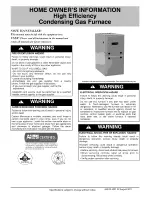
NON-DIRECT VENT (1-PIPE) APPLICATION
UNIT DAMAGE HAZARD
Failure to follow this caution may result in intermittent unit
operation.
Do not install furnace in a corrosive or contaminated atmo-
sphere. Make sure all combustion and circulating air require-
ments are met.
Refer to the AIR FOR COMBUSTION AND VENTILATION
section for details.
AIR FOR COMBUSTION AND VENTILATION
Provisions for adequate combustion, ventilation, and dilution air
must be provided in accordance with:
•
U.S. Installations: Section 8.3 of the NFGC, Air for Combus-
tion and Ventilation and applicable provisions of the local
building codes.
•
Canadian Installations: Part 7 of the NSCNGPIC, Venting
Systems and Air Supply for Appliances and all authorities
having jurisdiction.
FURNACE CORROSION HAZARD
Failure to follow this warning could result in reduced furnace
component life.
Air for combustion must not be contaminated by halogen
compounds, which include fluoride, chloride, bromide, and
iodide. These elements could corrode heat exchangers and
shorten furnace life. Air contaminants are found in aerosol
sprays, detergents, bleaches, cleaning solvents, salts, air
fresheners, and other household products.
The following types of furnace installations may require OUT-
DOOR AIR for combustion due to chemical exposures:
•
Commercial buildings
•
Buildings with indoor pools
•
Laundry rooms
•
Hobby or craft rooms, and
•
Chemical storage areas
If air is exposed to the following substances, it should not be used
for combustion air, and outdoor air may be required for combus-
tion:
•
Permanent wave solutions
•
Chlorinated waxes and cleaners
•
Chlorine based swimming pool chemicals
•
Water softening chemicals
•
De-icing salts or chemicals
•
Carbon tetrachloride
•
Halogen type refrigerants
•
Cleaning solvents (such as perchloroethylene)
•
Printing inks, paint removers, varnishes, etc.
•
Hydrochloric acid
•
Cements and glues
•
Antistatic fabric softeners for clothes dryers
•
Masonry acid washing materials
All fuel-burning equipment must be supplied with air for fuel
combustion. Sufficient air must be provided to avoid negative
pressure in the equipment room or space. A positive seal must be
made between the furnace cabinet and the return-air duct to
prevent pulling air from the burner area and from draft safeguard
opening.
CARBON MONOXIDE POISONING HAZARD
Failure to follow this warning could result in peronal injury or
death.
The operation of exhaust fans, kitchen ventilation fans,
clothes dryers, attic exhaust fans or fireplaces could create a
NEGATIVE PRESSURE CONDITION at the furnace.
Make-up air MUST be provided for the ventilation devices, in
addition to that required by the furnace. Refer to the Carbon
Monoxide Poisoning Hazard warning in the venting section
of these instructions to determine if an adequate amount of
make-up air is available.
The requirements for combustion and ventilation air depend upon
whether or not the furnace is located in a space having a volume
of at least 50 cubic feet per 1,000 Btuh input rating for all gas
appliances installed in the space.
•
Spaces having less than 50 cubic feet per 1,000 Btuh require
the OUTDOOR COMBUSTION AIR METHOD.
•
Spaces having at least 50 cubic feet per 1,000 Btuh may use the
INDOOR COMBUSTION AIR, STANDARD or KNOWN-
AIR INFILTRATION METHOD.
Outdoor Combustion Air Method
1. Provide the space with sufficient air for proper combustion,
ventilation, and dilution of flue gases using permanent hori-
zontal or vertical duct(s) or opening(s) directly communicat-
ing with the outdoors or spaces that freely communicate with
the outdoors.
2. Fig. 18 illustrates how to provide TWO OUTDOOR OPEN-
INGS, one inlet and one outlet combustion and ventilation air
openings to the outdoors.
a. One opening MUST commence within 12
″
(300 mm) of
the ceiling and the second opening MUST commence
within 12
″
(300 mm) of the floor.
b. Size openings and ducts per Fig. 18 and Table 1.
c. TWO HORIZONTAL DUCTS require 1 square inch of
free area per 2,000 Btuh (1,100 mm
2
/kW) of combined
input for all gas appliances in the space per Fig. 18 and
Table 1.
d. TWO OPENINGS OR VERTICAL DUCTS require 1
square inch of free area per 4,000 Btuh (550 mm
2
/kW) for
combined input of all gas appliances in the space per Fig.
18 and Table 1.
3. ONE OUTDOOR OPENING requires:
a. 1 square inch of free area per 3,000 Btuh (734 mm
2
/kW)
for combined input of all gas appliances in the space per
Table 1 and
Fig. 17—Installation in a Garage
A93044
18-IN. MINIMUM
TO BURNERS
16
→
→
→
















































